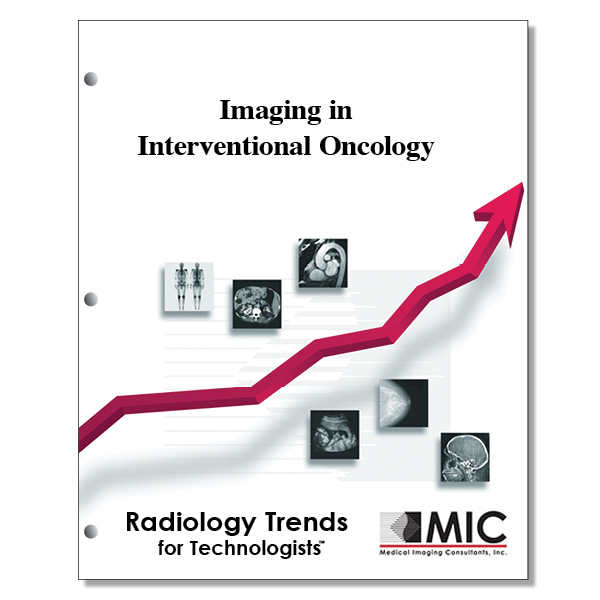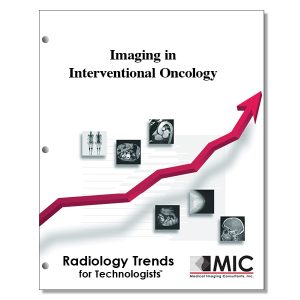

Imaging in Interventional Oncology
The roles of medical imaging in image-guided therapy and interventional oncology are presented.
Course ID: Q00370 Category: Radiology Trends for Technologists Modalities: CT, MRI, Nuclear Medicine, PET, Radiation Therapy, Sonography, Vascular Interventional4.0 |
Satisfaction Guarantee |
$39.00
- Targeted CE
- Outline
- Objectives
Targeted CE per ARRT’s Discipline, Category, and Subcategory classification:
[Note: Discipline-specific Targeted CE credits may be less than the total Category A credits approved for this course.]
Computed Tomography: 1.00
Safety: 0.25
Radiation Safety and Dose: 0.25
Procedures: 0.75
Neck and Chest: 0.25
Abdomen and Pelvis: 0.50
Magnetic Resonance Imaging: 0.75
Procedures: 0.75
Body: 0.75
Nuclear Medicine Technology: 0.75
Procedures: 0.75
Endocrine and Oncology Procedures: 0.75
Registered Radiologist Assistant: 1.00
Safety: 0.25
Patient Safety, Radiation Protection, and Equipment Operation: 0.25
Procedures: 0.75
Abdominal Section: 0.50
Thoracic Section: 0.25
Sonography: 0.75
Procedures: 0.75
Superficial Structures and Other Sonographic Procedures: 0.75
Radiation Therapy: 2.00
Procedures: 2.00
Treatment Sites and Tumors: 2.00
Vascular-Interventional Radiography: 0.75
Procedures: 0.75
Nonvascular Procedures: 0.75
Outline
- Introduction
- Imaging For Procedure Planning
- Imaging for Targeting
- Advances in Real-time Imaging
- Three-dimensional Visualization
- Contrast Agents
- Image Fusion
- Navigation
- Robotics
- Physician Access to the Patient
- Radiation Exposure
- Imaging for Intraprocedural Monitoring
- Imaging for Intraprocedural Control of Treatment
- Imaging for Postprocedural Therapy Assessment
Objectives
Upon completion of this course, students will:
- understand the benefits of image-guided procedures
- know the ideal properties of medical imaging during interventional oncology procedures
- list the five key roles in image-guided therapy and interventional oncology
- understand the first step in interventional oncology
- identify which imaging modalities deal with anatomic imaging
- understand the importance of pre-procedure image cross-referencing
- list the four types of interventional procedures
- know how blood is supplied to the liver
- recall how cancer cells in the liver receive blood supply
- describe the type of view offered by intra-procedural imaging
- list the new imaging techniques used when planning interventional oncology procedures
- discuss the type of imaging that best details treatment area, anatomy, interventional tools, and physiologic information
- know the meaning of ALARA
- understand the advantages to using CT fluoroscopy for interventional oncology procedures
- be familiar with cone-beam computed tomography
- know the uses of contrast media during interventional oncology procedures
- list the levels of reactions to iodine-based contrast material
- discuss contrast agent use in ultrasound in conjunction with radiofrequency ablation
- understand which metabolic imaging study has impacted detection and staging of cancer
- describe the challenges to fusing multiple modalities
- explain the advantages of hybrid interventional suites
- know how navigation technology in multi-modality image fusion assists the interventional oncologist
- be familiar with the use of robotics in interventional imaging
- discuss patient access in the different imaging modalities
- describe the limitations of interventional imaging via computed tomography
- explain the three principles of radiation protection
- understand how navigation software and fusion imaging decrease radiation exposure
- know the year in which the “Image Wisely” campaign was launched
- understand monitoring during interventional imaging
- be familiar with the various procedures that demonstrate post-embolization hemostasis
- define cryotherapy
- understand which imaging modalities visualize ice ball formation during cryotherapy
- understand using Doppler ultrasound to assess blood flow after embolization
- understand the use of mid-procedure angiography for control of interventional procedures
- explain how imaging is used for post-procedure management
- discuss imaging features associated with viable tissue identification after interventional oncology procedures
- understand the types of tissues that remain after ablation therapy
- list the goals of embolization therapy
- explain the Choi criteria for assessing post-therapy tumor attenuation
- identify the new imaging techniques that provide improved post-therapy tumor assessment
